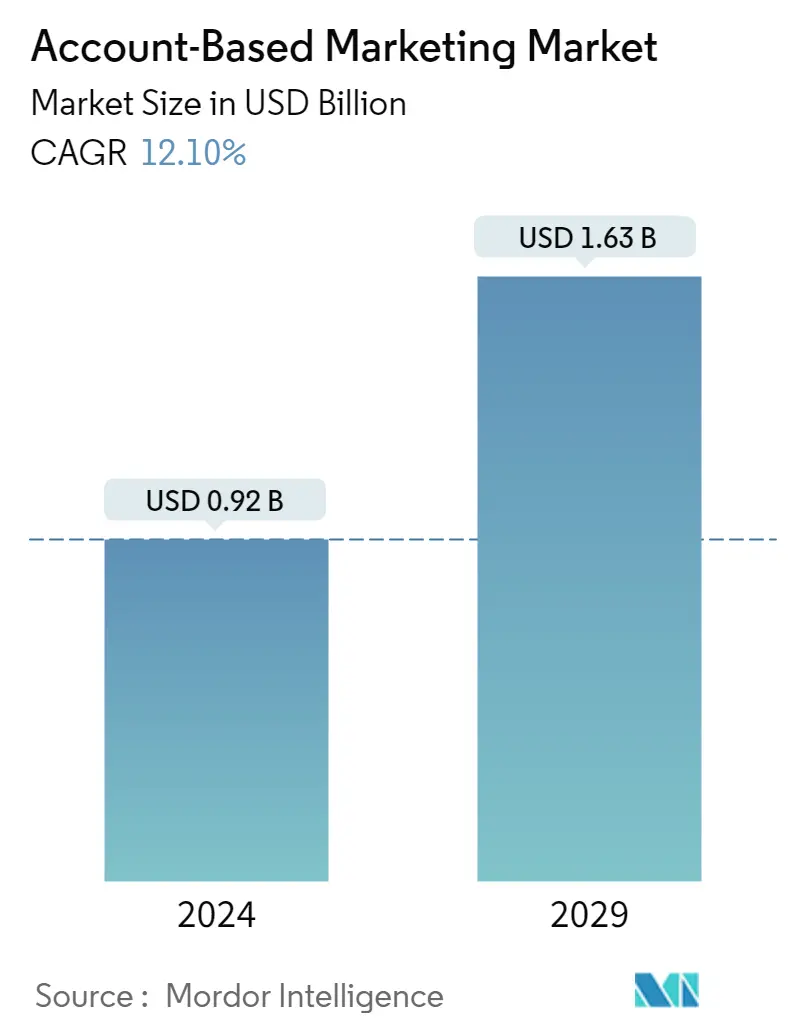Market Size of Account-Based Industrying Market

| Study Period | 2019 - 2029 |
| Market Size (2024) | USD 0.92 Billion |
| Market Size (2029) | USD 1.63 Billion |
| CAGR (2024 - 2029) | 12.10 % |
| Fastest Growing Market | Asia-Pacific |
| Largest Market | North America |
Major Players
*Disclaimer: Major Players sorted in no particular order |
Need a report that reflects how COVID-19 has impacted this market and its growth?
Account Based Marketing Market Analysis
The Account-Based Marketing Market size is estimated at USD 0.92 billion in 2024, and is expected to reach USD 1.63 billion by 2029, growing at a CAGR of 12.10% during the forecast period (2024-2029).
The Account-Based marketing is driven by the growing need to change the traditional, short-term goal of marketing, which is to get leads, into a more comprehensive strategy for long-term growth in sales.
- Even though inbound marketing is still essential for generating B2B lead generation, many marketers increasingly use ABM to regain control over the process, accelerate their acquisition cycles and discover more suitable ways to convert target accounts. The demand for ABM solutions on the market is driven by this shift from a reactive to a proactive marketing approach of B2B companies.
- The availability of vast data and advanced analytics tools has transformed the marketing landscape. ABM leverages data insights to identify ideal customer profiles, understand buying behavior, and create personalized campaigns. By harnessing data to drive decision-making and campaign execution, ABM allows marketers to optimize targeting, messaging, and engagement strategies, and engagement strategies resulting in higher conversion rates and ROI.
- Moreover, traditional advertising strategies usually aim to reach the broader possible audience and account for quality leads sometimes. By contrast, ABM focuses on quality rather than quantity. Companies are better capable of allocating resources efficiently and targeting accounts with a higher potential for conversion when they focus on groups of high-value accounts. The adoption of ABM is driven by this change from a broad spraying and prayer approach towards a more targeted and efficient strategy.
- As the implementation of ABM solutions requires significant resources in terms of time, budget, and workforce, developing personalized campaigns for individual target accounts becomes tricky and challenges the growth of the account-based marketing market.
- Due to the introduction of lockdown as a pandemic measure globally, in-place meetings at office locations were no longer an option, and sales and marketing teams struggled to find new ways to stay close to customers and prospects. As a result, to get closer to customers and generate more interest and interaction across all touchpoints has been shifted to Account-Based Marketing (ABM) strategies. Thus, as B2B buyers changed their way of engaging with companies, marketers, and vendors are increasingly started using ABM solutions.
- Different sectors had various problems as a result of the pandemic. In such cases, customization gained key importance in targeting a particular account. Therefore, a growing number of companies are now using account-based marketing strategies.
